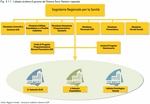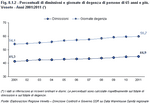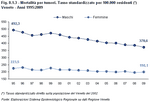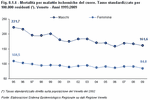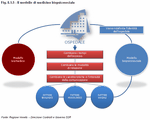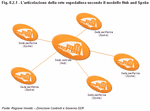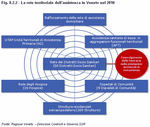
Chapter 8
The transformation of the regional health and social system (Note 1)
In order to meet the health needs expressed by the population and at the same time to ensure a more efficient distribution of the resources, the regional health and social system was subject of a gradual and continual process of transformation, modernisation and redefinition, under the pressure of national reforms.
The aim is to reduce the excessive burden which weighs on hospitals and prevents an effective and efficient allocation of resources, entrusting the territorial network of services with the chronic or more markedly social pathologies, cases requiring long-term assistance and long-term rehabilitation. Such reorganisation includes the promotion of forms alternative to hospital recovery through the enhancement of territorial health care facilities through a systematic approach.
Even hospitals were redefined, designed and connected as a network in order to facilitate accessibility of basic services and to make access to complex and technological services more efficient. At the same time this restructuring also aims at reinforcing the integration of hospitals with district services and primary care and social services to ensure continuity of assistance and a solid offer of intermediate care services. To enable continuity of assistance, the importance and necessity of integration between social and health assistance, which has always been one of the cornerstones of the Veneto system, must be recognised.
The aim is to reduce the excessive burden which weighs on hospitals and prevents an effective and efficient allocation of resources, entrusting the territorial network of services with the chronic or more markedly social pathologies, cases requiring long-term assistance and long-term rehabilitation. Such reorganisation includes the promotion of forms alternative to hospital recovery through the enhancement of territorial health care facilities through a systematic approach.
Even hospitals were redefined, designed and connected as a network in order to facilitate accessibility of basic services and to make access to complex and technological services more efficient. At the same time this restructuring also aims at reinforcing the integration of hospitals with district services and primary care and social services to ensure continuity of assistance and a solid offer of intermediate care services. To enable continuity of assistance, the importance and necessity of integration between social and health assistance, which has always been one of the cornerstones of the Veneto system, must be recognised.
Accountability and autonomy - The Regional Health Systems
The phases of birth and evolution of the Health and Social System of the Region of Veneto are characterised by a constant regulatory stratification in which some milestones can be found.
The origin of the Regional Authority's awareness of its responsibilities in the field of health care (awareness which was developed gradually) is to be sought in the establishment of 'Ordinary Statute Regions' (Law 16th May 1970, no. 281): from the beginning, in fact, the programming and management of health services were entrusted to the Regions. On this basis, in the old Statutes of the Veneto Region, approved in 1971, pursuant to article 4 '(...) the Veneto Region shall exercise its powers: (...) - to ensure social services to all citizens, with particular regard to housing, school, health protection, transport, sports equipment (...)'.
The approach to the matter indicated in this very initial phase appears to be aimed at social and health integration, which is still a distinctive element of the Veneto health system. Such an approach has developed and become more defined over the years immediately following the establishment of the Italian National Health Service (Law 23rd December 1978, no. 833) and its subsequent reorganization (Legislative Decree no. 502 on 30th December 1992), with the application of the principles of regionalisation and corporatisation of health care services. This process gave birth to some regional laws (no. 55 and no. 56 of 1994) which were fundamental in redefining the organisation of the Regional Health System and in identifying the methods and tools of planning, managing and controlling the Aziende Sanitarie (Health Care Units) units. In particular, article 8 of Regional Law no. 56 establishes that :
After this second phase dedicated to establishing the new structure of the service, further additional measures were adopted on the national level that then cascaded onto the Regions. In particular, the approval of Legislative Decree 19th June 1999, no. 229 containing the 'Rules for the rationalisation of the National Health Service, pursuant to article 1 of law 20th November 1998, no. 419 marked the beginning of the third cycle of the reforms of the health sector in Italy. The principles of regionalisation and corporatisation were further reinforced, and Veneto was found to be in a more advanced position compared to other Italian regions.
A first draft of tax federalism materialised in Legislative Decree 18th February 2000, no. 56, which was then consolidated by the constitutional Law 18th October 2001, no. 3, and the consequent reform of Title 5 of the Constitution: the individual Regions are the main players called upon to ensure Essential Levels of Health Care to everyone (President of the Council of Ministers 29th November 2001).
In this later phase, defined as that the maturity stage, the foundations were laid on which to identify the 'access keys' to the system and to articulate the processes needed for its maintenance and improvement. The foundations of quality, which have been present for a long time in Veneto, were officially included in the dialectic relationship between the Region and the Local Health Care Units and between Corporate Management and Internal Facilities Management. Regional law 16th August 2002, no. 22, identifies the preconditions required for obtaining authorisation to operate and for accreditation of health care facilities. Authorisation to operate refers to a procedure which, if successful, allows to operate in both the health and social domain. Accreditation refers to a procedure that, if concluded positively, allows to perform such activities on behalf of the Regional Health System. But this is not enough: some Health Care Units achieved accreditation of excellence according to internationally certified standards. This is not a mere assumption but an actual reality in some 'pioneer' Health Authorities of Veneto, such as the Local Health Care Unit 9 - Treviso and the Local Health Care Unit 1 - Belluno.
In the subsequent five years the adaptive/evolutionary phase then took place. The State - Regions Understanding concluded on 23rd March 2005 obligates the Regions to ensure economic and financial equilibrium and at the same time to maintain the Essential Assistance Levels (Note 2); all this led to the underwriting, on 28th September 2006, of the first 'Pact for Health' between the Government and the Regions, aimed at improving the quality of services, promoting the appropriateness of performance and ensuring consistency to the whole system.
Finally, among the other steps, the law of 5th May 2009, no. 42, gave the Government the power to legislate on tax federalism, implementing Article 119 of the Constitution, and to sign in 2009 the new 'Pact for Health' with the Regions, which commits them to 'ensure the financial balance of management in terms of efficiency and appropriateness' (Note 3).
The Veneto Region has orientated its social and health care programme on such bases and consequent constraints, aiming at a more effective control of expenditure whilst maintaining and improving the quality of the services provided to the citizens. (Figure 8.1.1)
The course outlined provides for a growing accountability of the Health Care Units and a greater equality in the allotment of the resources available to the various Local Social Health Care Units through the determination of standard costs.
The other area of regional programming is that of investments, with the simplification of the procedures for the examination, assessment and authorisation, through various forms of public and private partnerships, of interventions for the constructions of health care buildings and facilities and the acquisition of major equipment. Completing the framework is the centralised management of purchases, the development of the Social and Health Care Informative System and the improvement of budget control.
The first factor to be considered is quantitative. The rapid and progressive increase of the population in Veneto continues, now close to 5 million inhabitants. Over the last 10 years the average population of residents in the areas covered by the Local Social and Heath Care Units increased by about 19 thousand units. The demographic growth is considerable and requires the personnel of the Health Care Services to show notable effort and full commitment in providing the population with health care, social care and social assistance.
The second factor is represented by the composition of the population and the presence of a growing number of elderly people. Today, an average person of 65 years of age is still considered to be of full mental and physical capability, however, even in good conditions of health, starting from this age a person will undergo a greater number of planned or voluntary clinical checks; furthermore, as a person ages, healthcare needs become greater. If then, the social and economic situation of the elderly is characterised by a state of discomfort, social and health care needs increase further. All this represents an additional load on the Regional Social Health System.
A look at the percentage of discharges from hospital and days of hospitalisation of people who are 65 years of age or older can help understand the incidence of this age range on overall health needs. In 2011, people 65 years old or over represented 45% of the total discharges in Veneto and 60% of the days of hospitalisation, i.e. 5.6 percentage points more compared to 2001. This is also reflected in the whole territory with the gradual increase of the need for protected discharge, homecare assistance and related services. (Figure 8.1.2)
Above all, the progressive incidence of chronic diseases, increasing with age, leads to an increase of health care needs and thus access to territorial and hospital services. Chronic illnesses are by far the leading cause of death: in particular, diseases of the circulatory system and tumours cause about 70% of deaths. (Note 4).
Despite the aforementioned dynamics, the death rate for all the main chronic diseases have showed a strong decline over the last decade, due to the improvements in primary and specialist care and the living and labour conditions, the adoption of healthier lifestyles and the implementation of more extensive interventions aimed at prevention.
Mortality from ischemic heart disease has significantly decreased: the standardised rate (Note 5) in 2009 was 161.6 deaths for males and 84 deaths for females out of every 100,000 inhabitants, which compared to 1995 shows a decrease of 27% for the first and 23% for the second. This is a total of 2,992 deaths in males and 3,157 in females.
The rate of cerebrovascular diseases was 84.6 for males and 63 for females, with one of the most significant drops, over 40% less, both for males and females between 1995 and 2009.
Even the death rate for tumours has decreased by 25% in males and 11% in females, for a total of 7,795 deaths in males and 6,211 in females in 2009.
The marked decrease of mortality on one hand and a strong increase in the proportion of elderly on the other are the origin of the strong increase in the number of diseases to be cured and the necessity to move the diagnosis and care services from the hospital to the territory. (Figure 8.1.3), (Figure 8.1.4)
The third factor is the effect of migration: today, in Veneto there are about five hundred thousand foreign residents, more than triple compared to 10 years ago. With immigration comes particularly complex needs of a social and cultural nature (for example: difference in the approach to diseases and health services and communication problems) rather than strictly medical.
The fourth factor is identified by structural requirement. For a long time the Veneto Region has developed a process for the identification of the interventions required for health care buildings and major equipment, including the project proposals, project selection, subsequent funding and project implementation. The redefinition and strengthening of the Regional Commission for investment on Technology and Facilities, occurring in 2011, is part of the continual improvement of such process. On 11th December 2009 and 22nd March 2012, the fourth and fifth Integrative Programme Agreement was signed by the Minister of Health, the Minister of Economy and Finance and the Veneto Region, aimed at upgrading the hospital network, reorganising existing hospitals and adapting the standards to the minimum requirements. On 31/03/2012, 95.8% of the available funding was used for a total of 210 interventions.
The fifth and final factor considered here is the change in paradigm which occurred in the medical profession and more generally in all professions related to health. In the Eighties, a debate was developed which led to the definition of a new medicine model, defined as the bio-psycho-social model, proposed by the American psychiatrist George Libman Engel, according to which each health condition of disease is the consequence of interaction between biological, psychological and social factors. This model therefore exceeded the deterministic view of the biological model (if a symptom A is present related to clinical examinations with determined values, illness B therefore is present) to favour the approach which takes all the different aspects of the person into account.
For health care workers therefore, besides the signs, symptoms, laboratory and instrumental exams, also the evaluations and expectations of the patients are to be taken into consideration, as well as their capacity to participate actively in the courses of prevention, diagnosis, care and rehabilitation. (Figure 8.1.5)
The factors set out subsequently feed an ever increasing number needs on one hand, while on the other hand the issue of the limited financial resources becomes as crucial as ever, and is taken as the factor allowing comparison between the State and the Regions. The Veneto Region plays a leading role in this context, serving as the Coordinator of the Health Commission of the Conference of the Regions. In this phase, eight topics are identified as priorities:
The phases of birth and evolution of the Health and Social System of the Region of Veneto are characterised by a constant regulatory stratification in which some milestones can be found.
The origin of the Regional Authority's awareness of its responsibilities in the field of health care (awareness which was developed gradually) is to be sought in the establishment of 'Ordinary Statute Regions' (Law 16th May 1970, no. 281): from the beginning, in fact, the programming and management of health services were entrusted to the Regions. On this basis, in the old Statutes of the Veneto Region, approved in 1971, pursuant to article 4 '(...) the Veneto Region shall exercise its powers: (...) - to ensure social services to all citizens, with particular regard to housing, school, health protection, transport, sports equipment (...)'.
The approach to the matter indicated in this very initial phase appears to be aimed at social and health integration, which is still a distinctive element of the Veneto health system. Such an approach has developed and become more defined over the years immediately following the establishment of the Italian National Health Service (Law 23rd December 1978, no. 833) and its subsequent reorganization (Legislative Decree no. 502 on 30th December 1992), with the application of the principles of regionalisation and corporatisation of health care services. This process gave birth to some regional laws (no. 55 and no. 56 of 1994) which were fundamental in redefining the organisation of the Regional Health System and in identifying the methods and tools of planning, managing and controlling the Aziende Sanitarie (Health Care Units) units. In particular, article 8 of Regional Law no. 56 establishes that :
- The Region shall pursue the integration of health and social policies and promote the delegation of health and social services management by the Municipalities to the Social and Health Care Local Units, also by providing specific funding, according to the methods defined by the Regional Plan for Social and Health Care.
- The Region shall also pursue the integration of the activities performed by public and private entities both at the Municipality and at an intra-municipal level in territorial areas corresponding to those defined for the new for Social and Health Care Local Units .
After this second phase dedicated to establishing the new structure of the service, further additional measures were adopted on the national level that then cascaded onto the Regions. In particular, the approval of Legislative Decree 19th June 1999, no. 229 containing the 'Rules for the rationalisation of the National Health Service, pursuant to article 1 of law 20th November 1998, no. 419 marked the beginning of the third cycle of the reforms of the health sector in Italy. The principles of regionalisation and corporatisation were further reinforced, and Veneto was found to be in a more advanced position compared to other Italian regions.
A first draft of tax federalism materialised in Legislative Decree 18th February 2000, no. 56, which was then consolidated by the constitutional Law 18th October 2001, no. 3, and the consequent reform of Title 5 of the Constitution: the individual Regions are the main players called upon to ensure Essential Levels of Health Care to everyone (President of the Council of Ministers 29th November 2001).
In this later phase, defined as that the maturity stage, the foundations were laid on which to identify the 'access keys' to the system and to articulate the processes needed for its maintenance and improvement. The foundations of quality, which have been present for a long time in Veneto, were officially included in the dialectic relationship between the Region and the Local Health Care Units and between Corporate Management and Internal Facilities Management. Regional law 16th August 2002, no. 22, identifies the preconditions required for obtaining authorisation to operate and for accreditation of health care facilities. Authorisation to operate refers to a procedure which, if successful, allows to operate in both the health and social domain. Accreditation refers to a procedure that, if concluded positively, allows to perform such activities on behalf of the Regional Health System. But this is not enough: some Health Care Units achieved accreditation of excellence according to internationally certified standards. This is not a mere assumption but an actual reality in some 'pioneer' Health Authorities of Veneto, such as the Local Health Care Unit 9 - Treviso and the Local Health Care Unit 1 - Belluno.
In the subsequent five years the adaptive/evolutionary phase then took place. The State - Regions Understanding concluded on 23rd March 2005 obligates the Regions to ensure economic and financial equilibrium and at the same time to maintain the Essential Assistance Levels (Note 2); all this led to the underwriting, on 28th September 2006, of the first 'Pact for Health' between the Government and the Regions, aimed at improving the quality of services, promoting the appropriateness of performance and ensuring consistency to the whole system.
Finally, among the other steps, the law of 5th May 2009, no. 42, gave the Government the power to legislate on tax federalism, implementing Article 119 of the Constitution, and to sign in 2009 the new 'Pact for Health' with the Regions, which commits them to 'ensure the financial balance of management in terms of efficiency and appropriateness' (Note 3).
The Veneto Region has orientated its social and health care programme on such bases and consequent constraints, aiming at a more effective control of expenditure whilst maintaining and improving the quality of the services provided to the citizens. (Figure 8.1.1)
The course outlined provides for a growing accountability of the Health Care Units and a greater equality in the allotment of the resources available to the various Local Social Health Care Units through the determination of standard costs.
The other area of regional programming is that of investments, with the simplification of the procedures for the examination, assessment and authorisation, through various forms of public and private partnerships, of interventions for the constructions of health care buildings and facilities and the acquisition of major equipment. Completing the framework is the centralised management of purchases, the development of the Social and Health Care Informative System and the improvement of budget control.
The challenges of the present and the future: increase in needs and scarcity of resources
A constant dynamic in the social heath sector is the enlargement of needs faced with the scarcity of financial resources. From the aging of the population to large-scale migration, to name but a few, there are many elements which need attention. Also included among these are aspects related to structural requirements and the organisational changes determined by a different way of approaching the medical and nursing profession, to technological evolution and to control of expenditure. Below is a brief survey of some factors which have major incidence on the dynamic of the Social Health System.The first factor to be considered is quantitative. The rapid and progressive increase of the population in Veneto continues, now close to 5 million inhabitants. Over the last 10 years the average population of residents in the areas covered by the Local Social and Heath Care Units increased by about 19 thousand units. The demographic growth is considerable and requires the personnel of the Health Care Services to show notable effort and full commitment in providing the population with health care, social care and social assistance.
The second factor is represented by the composition of the population and the presence of a growing number of elderly people. Today, an average person of 65 years of age is still considered to be of full mental and physical capability, however, even in good conditions of health, starting from this age a person will undergo a greater number of planned or voluntary clinical checks; furthermore, as a person ages, healthcare needs become greater. If then, the social and economic situation of the elderly is characterised by a state of discomfort, social and health care needs increase further. All this represents an additional load on the Regional Social Health System.
A look at the percentage of discharges from hospital and days of hospitalisation of people who are 65 years of age or older can help understand the incidence of this age range on overall health needs. In 2011, people 65 years old or over represented 45% of the total discharges in Veneto and 60% of the days of hospitalisation, i.e. 5.6 percentage points more compared to 2001. This is also reflected in the whole territory with the gradual increase of the need for protected discharge, homecare assistance and related services. (Figure 8.1.2)
Above all, the progressive incidence of chronic diseases, increasing with age, leads to an increase of health care needs and thus access to territorial and hospital services. Chronic illnesses are by far the leading cause of death: in particular, diseases of the circulatory system and tumours cause about 70% of deaths. (Note 4).
Despite the aforementioned dynamics, the death rate for all the main chronic diseases have showed a strong decline over the last decade, due to the improvements in primary and specialist care and the living and labour conditions, the adoption of healthier lifestyles and the implementation of more extensive interventions aimed at prevention.
Mortality from ischemic heart disease has significantly decreased: the standardised rate (Note 5) in 2009 was 161.6 deaths for males and 84 deaths for females out of every 100,000 inhabitants, which compared to 1995 shows a decrease of 27% for the first and 23% for the second. This is a total of 2,992 deaths in males and 3,157 in females.
The rate of cerebrovascular diseases was 84.6 for males and 63 for females, with one of the most significant drops, over 40% less, both for males and females between 1995 and 2009.
Even the death rate for tumours has decreased by 25% in males and 11% in females, for a total of 7,795 deaths in males and 6,211 in females in 2009.
The marked decrease of mortality on one hand and a strong increase in the proportion of elderly on the other are the origin of the strong increase in the number of diseases to be cured and the necessity to move the diagnosis and care services from the hospital to the territory. (Figure 8.1.3), (Figure 8.1.4)
The third factor is the effect of migration: today, in Veneto there are about five hundred thousand foreign residents, more than triple compared to 10 years ago. With immigration comes particularly complex needs of a social and cultural nature (for example: difference in the approach to diseases and health services and communication problems) rather than strictly medical.
The fourth factor is identified by structural requirement. For a long time the Veneto Region has developed a process for the identification of the interventions required for health care buildings and major equipment, including the project proposals, project selection, subsequent funding and project implementation. The redefinition and strengthening of the Regional Commission for investment on Technology and Facilities, occurring in 2011, is part of the continual improvement of such process. On 11th December 2009 and 22nd March 2012, the fourth and fifth Integrative Programme Agreement was signed by the Minister of Health, the Minister of Economy and Finance and the Veneto Region, aimed at upgrading the hospital network, reorganising existing hospitals and adapting the standards to the minimum requirements. On 31/03/2012, 95.8% of the available funding was used for a total of 210 interventions.
The fifth and final factor considered here is the change in paradigm which occurred in the medical profession and more generally in all professions related to health. In the Eighties, a debate was developed which led to the definition of a new medicine model, defined as the bio-psycho-social model, proposed by the American psychiatrist George Libman Engel, according to which each health condition of disease is the consequence of interaction between biological, psychological and social factors. This model therefore exceeded the deterministic view of the biological model (if a symptom A is present related to clinical examinations with determined values, illness B therefore is present) to favour the approach which takes all the different aspects of the person into account.
For health care workers therefore, besides the signs, symptoms, laboratory and instrumental exams, also the evaluations and expectations of the patients are to be taken into consideration, as well as their capacity to participate actively in the courses of prevention, diagnosis, care and rehabilitation. (Figure 8.1.5)
The factors set out subsequently feed an ever increasing number needs on one hand, while on the other hand the issue of the limited financial resources becomes as crucial as ever, and is taken as the factor allowing comparison between the State and the Regions. The Veneto Region plays a leading role in this context, serving as the Coordinator of the Health Commission of the Conference of the Regions. In this phase, eight topics are identified as priorities:
- continuity of care and integration of social and health care;
- plans for renovation and reorganisation of assistance services and recovery of the deficit;
- investments for technological updates and relative costs;
- Universities - National Health Service relations;
- rules and requirements for the provision of services;
- health care professionals and professions;
- Essential Levels of Assistance;
- health information flow.
Development of assistance in the territory and optimisation of the hospital network
The Veneto Region is redefining its strategies in the Social and Health Care Plan 2012-2016, currently being examined by the Regional Council. The Report (Note 6) which introduces the Draft regional law reads as follows: ' the contents of programming need to be reviewed, in order to adapt the system to the social and epidemiological changes and, at the same time, to innovate the organisational models on the basis of the best practices achieved in recent years, pursuing the goals of efficiency, effectiveness and economic efficiency'.The Veneto Region intends to take this opportunity to improve its Social and Health Care System while preserving its excellence. From this point of view, the strategic choices of regional programming are as follows:
- to confirm and consolidate integration of social and health care services, which constitutes the distinctive element of the Regional Social Health System;
- to strengthen assistance and care services on the territory, consolidating the role of the Social and Health Care District, redesigning the territorial network to create a chain able to ensure a care system founded on the needs of the person and equipped to face intensive care needs;
- to complete the streamlining of the hospital network, outlining functional operational clinical networks and spreading hospital models in which hospitalisation is defined based on similarities of needs, in terms of clinical complexity and intensity of the required care;
- to assume initiatives to promote proper use of professional resources, redefining the operational models, standards and parameters with which to measure the organisation of work and the consequent need for personnel.
The completion of the rationalisation process of the hospital network is to be achieved through a two level model:
- reference hospitals in the province: they should offer basic and mid-level specialities for the territory of reference, including high level specialities for a wider territory, creating Hub centres above the level of the Local Health Authority;
- network of hospital facilities: they should offer minimum services, i.e. an Accident & Emergency department and basic specialities of medium complexity specialities, and ensure diagnostic and care services to be provided within a 'network' including the previous level so as to create the Spoke centres (Note 10). (Figure 8.2.1)
Completing the framework is the progressive evolution of associations of Primary Care Medicine into the Medicine di Gruppo Integrate (Integrated Group Medicine Units), at the heart of which is the reorganisation of the entire structure of territorial care. (Figure 8.2.2)
The Integrated Group Medicine Units, which in 2010 involved about 8% of Primary Care Doctors and 9% of patients in the Veneto Region, are designed to unite into a single team of family doctors, private paediatricians, nurses of the districts and of the group medicine units, rehabilitation therapists, geriatricians and palliative carers, day unit specialists and continual care specialists, combined in a network with the municipal social services. The Group therefore represents a reference point for the patient, ensuring continuity of care and assistance from a relationship, management and informative point of view (Note 11). At a functional level, all the professionals who work in primary care in a catchment basin of about 30,000 inhabitants are integrated and coordinated by the the Aggregazioni Funzionali Territoriali (Territorial Functional Aggregation Units), which are coordinated by a Family Doctor.
The challenges proposed by the increase of needs and the contraction of governmental resources are grasped by the Regional Administration as opportunities to refine a system for the integrated management of the patient, founded on the continuity of care and assistance, integration of services and the collaboration of different health professionals.
Quality aspects of the regional Health and Social Care System
According to traditional distinction, quality covers three dimensions, each one of which can be read as an expression of the requirements of the main stakeholders, integrated and related with each other in order to build the specific quality of a service. Quality can therefore be split as follows:- organisational quality, i.e. the most effective and productive use of resources by the management, pursuing objectives fixed by the regional authorities or the entities which acquire the services;
- professional quality, which identifies the role and the point of view of the professionals and the operators which provide care and assistance;
- citizens-users satisfaction, including their expectations as individuals as a group.
With regard to the number of bed-places per 1000 inhabitants, Veneto is in an excellent situation compared to the other European Union Countries and comparable to that of the United Kingdom and Sweden. The Region has among its objectives that of adapting the number of bed-places for ordinary inpatient admissions to the following standards: 3‰ bed-places for acute patients; 0,5‰ bed-places for post acute patients; 1.2‰ bed-places for extra-hospital facilities especially in intermediate hospitalisation facilities. (Table 8.2.1)
An example of professional quality linked to the 'Hub and Spoke' model described above is the cardiology network.
Acute myocardial infarction (AMI) is one of the main causes of death and disability in the West; it constitutes one of the most frequent medical emergencies and requires an extremely efficient healthcare organisation to for the most effective care to be provided in a timely manner.
In Veneto as of 2007, the hemodynamic services of hospitals have been structured according to the 'Hub and Spoke' model: the 'Spoke' centres are able to ensure daytime cover while the 'Hub' centres ensure 24 hours coverage seven days a week and are a pivotal point for the peripheral centres. The 'Hub' centres are able to achieve the level of specialisation proper of interventional cardiologists and of their team, with the presence of third-level services (cardiac surgery) which allow to operate with maximum efficiency and clinical safety. It has in fact been long recognised internationally that the best clinical results are obtained in centres which are capable of delivering at least 400 coronary angioplasties per year. The percentage of patients with AMI seen in these type of centres has increased after the establishment of the cardiology network by 11 percentage points (74% - 85%).
When the patient following infarction is reached by the ambulance, the diagnosis is confirmed with an ECG which is sent electronically to the local centre. In this way, even during the ambulance journey, it is possible to identify which hospital the patient should be taken to, reducing intervention times to a minimum. Such an organisation, by ensuring greater appropriateness and timeliness in the care, has led to an increase in the number of coronary angioplasty surgical interventions (the so-called 'balloon') performed within 24 hours from 8% in 2000 to 34% in 2009.
With regard to citizen-user satisfaction, the Regional Social Healthcare Services Unit (Note 13) in 2008 carried out a survey on the perceived quality of hospital care using the Picker Institute method. The responses received were 67% out of a sample of 19,000 respondents, which allowed the identification of the strengths and weaknesses of the various phases of the hospital recovery experience. The overall opinion expressed by the patients on their hospital recovery experience was excellent, very good or good for 89.5% of respondents and inadequate for 1.7%; this result appears to be strictly correlated to the trust of patients in the doctors and nurses, which was expressed as 81% and 74.6% respectively (it was negative in 3% of cases) and the level of cooperation between the doctors and nurses was assessed as excellent, very good or good by 88.7% of patients (it was negative in 1.7% of cases).
The outlook: subsidiarity and proximity horizon
Evolution from a centralised system to a polycentric system having the Regions as its protagonists, find Veneto in the most advanced positions in the field of Social and Health Care. Today, based on the proposal of the Social and Health Care Plan 2012-2016, the Regional Social and Health Care System embodies four fundamental principles:- universality, i.e. being addressed to the whole target population;
- equality, i.e. ensuring equal opportunities in achieving and maintaining individual health objectives and ensuring uniformity of services over the regional territory;
- humanisation of social healthcare assistance;
- social and health care integration (Note 14).
From this point of view, the Social and Health Care Plan firstly represents a pact with the local community; the institutional integration widens, also involving non institutional entities in the creation of a 'community partnership' (Note 15). The Region enters into a proximity horizon in which, through virtuous relationships, it is able to respond in a more effective and efficient manner to the needs of citizens.
Therefore, the characteristics of the Social and Health Care System which we have briefly described, in addition to being a reason of pride, attest that the approach used to seize new opportunities, can only rest on solid and vigorous roots.







